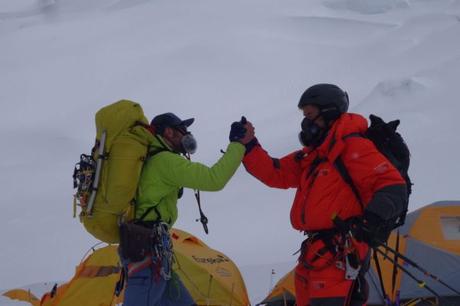 Amidst all of the other summits of the big mountains in Nepal this past week, there is one interesting story that has captured the attention of the mountaineering community and created a bit of a rift at the same time. This controversial expedition has caused some to reconsider how to train for their high altitude endeavors, while others find it to be unconventional enough to label it as "unfair means." Either way, it could be part of the future of climbing as others pick up on the approach.
Amidst all of the other summits of the big mountains in Nepal this past week, there is one interesting story that has captured the attention of the mountaineering community and created a bit of a rift at the same time. This controversial expedition has caused some to reconsider how to train for their high altitude endeavors, while others find it to be unconventional enough to label it as "unfair means." Either way, it could be part of the future of climbing as others pick up on the approach.Last Sunday, Adrian Ballinger – of Alpenglow Expeditions – and his partner Emily Harrington completed a successful summit of Cho Oyu, the sixth highest mountain on the planet at 8188 meters (26,884 ft). That in and of itself wasn't too unusual, as a number of teams topped out during a great summit window last weekend. But, Adrian and Emily did it just ten days after leaving their home in California, something that has been unheard of until now.
Typically on a big Himalayan peak it takes weeks to acclimatize to the altitude. Most climbers arrive in Kathmandu two months prior to their projected summit date. They then travel to their respective base camps, follow a set process for acclimatization by going up and down the mountain several times, and wait for good weather to make a summit bid after their bodies have acclimated to the thin air. That can sometimes take 4-6 weeks, depending on conditions and the climbing schedule.
But Adrian and Emily trained back home using altitude tents to simulate the conditions they would find on the mountain. These tents were able to create an environment that closely approximates the thin air of a big Himalayan peak, but it allows them to stay home, sleep in their own beds, and have the comforts that they are typically accustomed too. Meanwhile, a support team established a Base Camp for them on Cho Oyu, making it ready for their arrival.
Two weeks ago, Ballinger and Harrington left the U.S. to fly to Nepal and then traveled to Tibet to reach the mountain. By the time they reached BC, they were fit, acclimated, and pretty much ready to go. Once the weather window opened last week, they were able to safely climb to the top, taking two clients who had prepared in a similar fashion along with them.
This approach to acclimatizing at home and shortening the length of an expedition isn't new. In fact, it is something that Ballinger and Alpenglow have been working on for some time. The company's Everest expeditions are just a month in length thanks to this novel program, and now he has proven that he can shorten the time considerably on shorter peaks too. This allows clients to spend less time on a potentially dangerous mountain, while having to be away from home for fewer days too. That makes it vacation friendly as well. The downside? An Alpenglow expedition is considerably more expensive than the competition.
This new approach has rankled some in the mountaineering community in the past, but this new Cho Oyu speed ascent has many talking once again. For some, it is an innovative new way to climb in the Himalaya, while others feel like it is still a bit unproven and could be potentially risky. There are those who see it as a bit of "cheating" – for lack of a better word – as well. Those detractors tend to be old school climbers who often consider the use of bottled oxygen as a performance enhancing drug too.
Either way, this could be the future of mountaineering. Alpenglow will of course continue to pursue this novel training technique with the idea of attracting more clients who want to climb on the big peaks, but don't necessarily have two months to dedicate to that proposition. As Ballinger and his team continue to refine their methods, I'm sure more than a few other climbers and guides will be looking to employ similar techniques to aid their expeditions as well.

